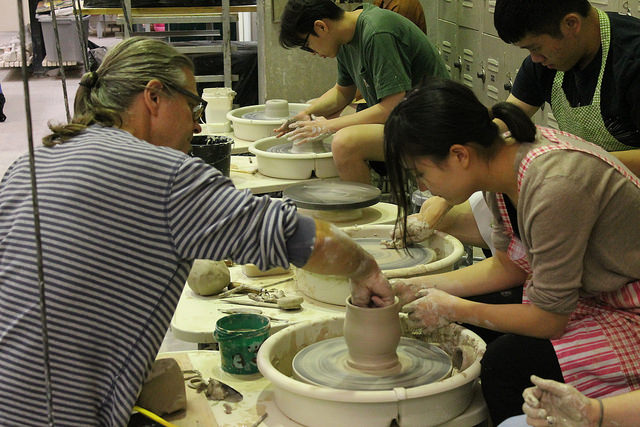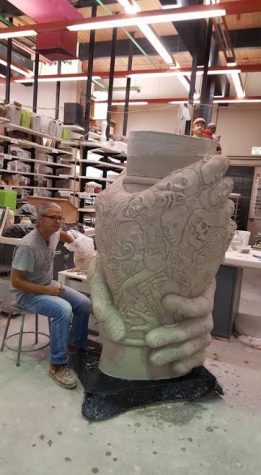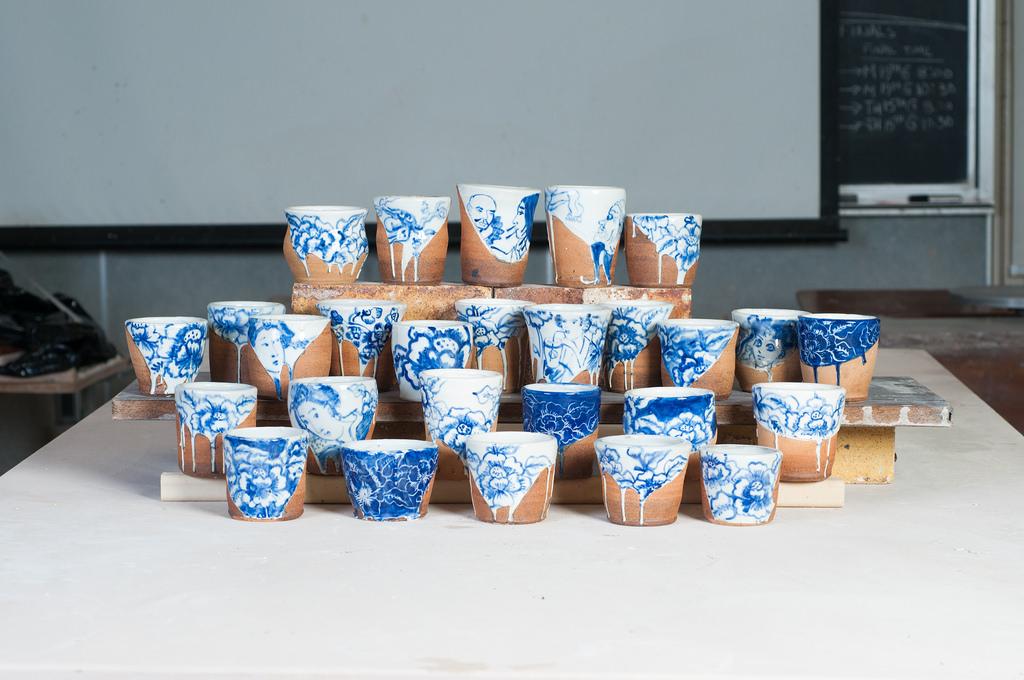Holism in the art world of Mark Messenger
Ceramics instructor Mark Messenger helps Emma Wu craft a piece on the throwing wheel on November 3, 2016.
December 4, 2016
Diablo Valley College’s own ceramics professor Mark Messenger aims to welcome students into a nurturing space and wants them to realize the correlation between creating art and problem solving.
“It’s inspiring to assist students. There are always projects going and each individual has a unique approach. And watching students develop their own solutions and style is really gratifying. This is ‘problem solving’ within specific parameters and it’s the crux of any studio or lab experience but there’s more,” he said.
Messenger elaborated on the connection between art and problem solving, “The first step to resolving a problem is defining it. An instructor or boss usually does this, but individuals can also set their own parameters. This is the ability, unique in any field, to devise a beautiful question. This is not confined to studios or labs, but it happens in them a lot.”
His classes are influenced by artists and scientific greats like Da Vinci, Einstein, Fromm, Tesla and Jobs, to name a few.
“They (the students) discover a potential, both personal and collective, for progress. A potential enabled through creative, ethical ‘problem formulation.’ Nurturing an environment in which this is possible is what I like most about teaching,” he said.
Messenger emphasized how the benefits of gaining this problem-solving skill can be useful in and outside of an art studio, “This is called STEAM and involves an equal emphasis on Science, Technology, Engineering, Art and Math. Unfortunately, there is also an abbreviated version, STEM presently under discussion here at DVC. Fortunately, the most recent studies and articles point out the shortcomings of this simplification clearly. A STEM emphasis, without equal attention to the arts and humanities is dangerous. History is filled with examples of effectively destructive technocrats, from the mythical Daedalus to the horrifically concrete Albert Speers from the Third Reich. I don’t think this is our community goal. One can only hope that this incompatibility is obvious.”
Messenger occupies a rare space in art. He’s a satirist who conveys a political message through his sculptures. He is motivated by his frustration with lack of leadership and transparency in government, and with the overextension of funds in multiple wars overseas with no endgame.
Messenger enjoys working with students at any stage of learning, from the complete novice to the more skilled craftsman who is already manufacturing dish sets.
“There is my Art 151 class on Fridays, which is interesting because this is where I encounter students who may not have studied art before. It gives people an opportunity to show themselves the technical side to ceramic art. They study different eras and then get to produce it at the same time,” he said. “And it’s really important because this may be the only time this student will experience art in their life. Then my responsibility is making sure they have a good experience.”
Students in Messenger’s classes can attest to their positive experience.
Natalie Francine, a third semester art student at DVC said, “Mark Messenger has been very supportive as an instructor no matter what direction you want your semester to go in. I get to create what I want.”
Randy Stansberry, painter and long-term student at DVC said, “Mark Messenger is very organized, knowledgeable, kind and a good art teacher who is ready to teach. Once, a few years back when my fiancé had passed away, I emailed him saying I would be out for a week. When I came back he stopped teaching and gave me a hug and that made a positive impact on me, considering that was my first semester taking classes with him.”
A long time student of Messenger’s, Adam Swanson said, “Mark is a gifted teacher and potter. His explanations are clear. He’s a very good teacher for beginners because he doesn’t criticize or have an agenda. He has a passion for clay, firing, potting, sculpture that is undiminished even after years in the field. He is not burnt out or getting a pay check but loves creating, sculpting, potting and teaching, a very unusual combination.”
Messenger said, with regard to being an art teacher, “There’s never a dull day. I always look forward to teaching and to seeing what my students are doing, there’s always something interesting to be working on. I’ve heard it said that if you’re bored, it’s your fault and I’m never bored. There’s a lot of busy work, but that’s just part of the whole package.”
Speaking of never being bored, on his off days he can be found in art galleries, fishing through art books or newspapers for ideas or simply finding inspiration from getting his hands deep in clay and seeing what wants to be born.
Travel is also a big part of his life. “I have taken several sabbaticals where all I do is work. I went to Greece, Ecuador and it’s always special because I can just take sketches and work from morning ’til night,” he said.
As for what’s in store for the future, Messenger is currently working on a piece for the National Council on Education for the Ceramic Arts conference. (NCECA)
“About NCECA, it’s an annual show that is both east and west coast and renowned internationally – this years it’s in Portland. I started on the new work in February, entitled ‘Cliffhanger.’ I don’t know if I will finish it in time.”
“It’s like that moment in a movie, or in life where the person is at the edge of a cliff and falling and their hands make contact with someone pulling them up and it’s life or death and- those hands are what I depict. It’s not like these are all good people or bad people, that would be simple. I mean, I teach. I sleep. I work onmy sculptures. You just keep working. That’s all you can do.”








































































